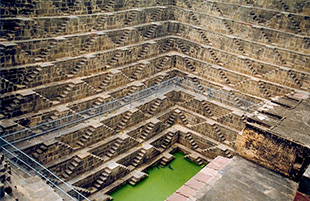












They may be covered and protected, and are often of architectural significance. They are most common in the west of India. They may be also found in the other more arid regions of the subcontinent, extending into Pakistan. The construction may be utilitarian, but sometimes includes significant architectural embellishments.
A number of distinct names, sometimes local, exist for stepwells. In Hindi speaking regions, they include names based on baudi (including bawdi, bawri, baoli, bavadi). In Gujarati and Marwari language, they are usually called vav.
All forms of the stepwell may be considered to be particular examples of the many types of storage and irrigation tanks that were developed in India, mainly to cope with seasonal fluctuations in water availability. A basic difference between stepwells on the one hand, and tanks and wells on the other, was to make it easier for people to reach the ground water, and to maintain and manage the well.
In some related types of structure (johara wells), ramps were built to allow cattle to reach the water. The majority of surviving stepwells originally also served a leisure purpose, as well as providing water. This was because the base of the well provided relief from daytime heat, and more such relief could be obtained if the well was covered. This led to the building of some significant ornamental and architectural features, often associated with dwellings and in urban areas. It also ensured their survival as monuments.
Stepwell construction is known to have gone on from at least 600 CE. Most existing stepwells date from the last 800 years. There are suggestions that they may have originated much earlier, and there are some suggestions that precursors to them can be seen in the Indus Valley civilisation.
By Appointment
DE FERRANTI
South Park Studios - Suite 10
88 Peterborough Road, London SW6 3HH
United Kingdom